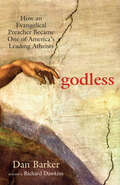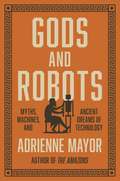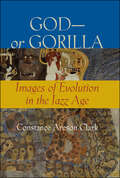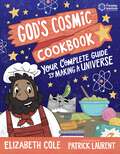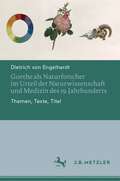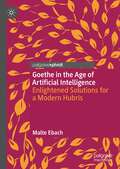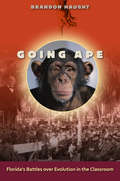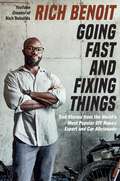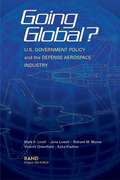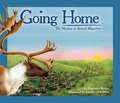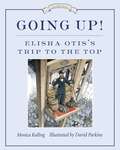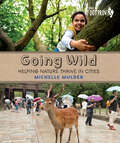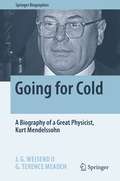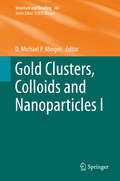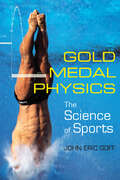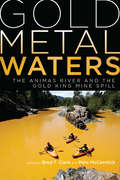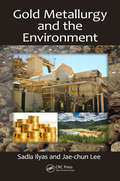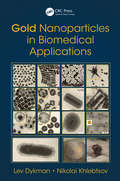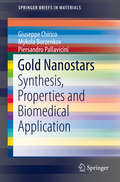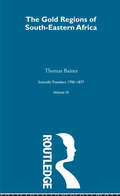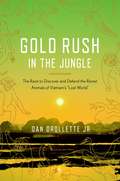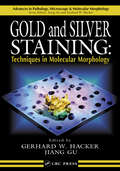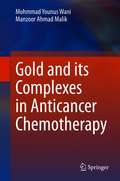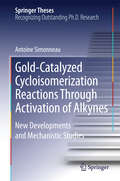- Table View
- List View
Godless: How an Evangelical Preacher Became One of America's Leading Atheists
by Dan BarkerOne man shares the story of his transformation from evangelical Christian to atheist and examines the train of thought that brought him there.After almost twenty years of evangelical preaching, missionizing, and Christian songwriting, Dan Barker “threw out the bathwater and discovered that there is no baby.” In Godless, Barker describes the intellectual and psychological path he followed in moving from fundamentalism to freethought. Godless includes sections on biblical morality, the historicity of Jesus, biblical contradictions, the unbelievable resurrection, and much more. It is an arsenal for skeptics and a direct challenge to believers. Along the way, Barker relates the positive benefit readers will experience from learning to trust in reason and human kindness instead of living in fear of false judgment and moral condemnation.Advance Praise for Godless“Valuable in the human story are the reflections of intelligent and ethical people who listen to the voice of reason and who allow it to vanquish bigotry and superstition. This book is a classic example.” —Christopher Hitchens, author of God is Not Great“The most eloquent witness of internal delusion that I know—a triumphantly smiling refugee from the zany, surreal world of American fundamentalist Protestantism—is Dan Barker.” —Richard Dawkins, author of The God Delusion“Godless was a revelation to me. I don’t think anyone can match the (devastating!) clarity, intensity, and honesty which Dan Barker brings to the journey—faith to reason, childhood to growing up, fantasy to reality, intoxication to sobriety.” —Oliver Sacks, author of Musicophilia“In Godless, Barker recounts his journey from evangelical preacher to atheist activist, and along the way explains precisely why it is not only okay to be an atheist, it is something in which to be proud.” —Michael Shermer, publisher of Skeptic Magazine“Godless is a fascinating memoir and a handbook for debunking theism. But most of all, it is a moving testimonial to one man’s emotional and intellectual rigor in acclaiming critical thinking.” —Robert Sapolsky author of Why Zebras Don’t Get Ulcers
Gods and Robots: Myths, Machines, and Ancient Dreams of Technology
by Adrienne MayorThe fascinating untold story of how the ancients imagined robots and other forms of artificial life—and even invented real automated machinesThe first robot to walk the earth was a bronze giant called Talos. This wondrous machine was created not by MIT Robotics Lab, but by Hephaestus, the Greek god of invention. More than 2,500 years ago, long before medieval automata, and centuries before technology made self-moving devices possible, Greek mythology was exploring ideas about creating artificial life—and grappling with still-unresolved ethical concerns about biotechne, “life through craft.” In this compelling, richly illustrated book, Adrienne Mayor tells the fascinating story of how ancient Greek, Roman, Indian, and Chinese myths envisioned artificial life, automata, self-moving devices, and human enhancements—and how these visions relate to and reflect the ancient invention of real animated machines.As early as Homer, Greeks were imagining robotic servants, animated statues, and even ancient versions of Artificial Intelligence, while in Indian legend, Buddha’s precious relics were defended by robot warriors copied from Greco-Roman designs for real automata. Mythic automata appear in tales about Jason and the Argonauts, Medea, Daedalus, Prometheus, and Pandora, and many of these machines are described as being built with the same materials and methods that human artisans used to make tools and statues. And, indeed, many sophisticated animated devices were actually built in antiquity, reaching a climax with the creation of a host of automata in the ancient city of learning, Alexandria, the original Silicon Valley.A groundbreaking account of the earliest expressions of the timeless impulse to create artificial life, Gods and Robots reveals how some of today’s most advanced innovations in robotics and AI were foreshadowed in ancient myth—and how science has always been driven by imagination. This is mythology for the age of AI.
God—or Gorilla: Images of Evolution in the Jazz Age (Medicine, Science, and Religion in Historical Context)
by Constance A. ClarkAs scholars debate the most appropriate way to teach evolutionary theory, Constance Areson Clark provides an intriguing reflection on similar debates in the not-too-distant past. Set against the backdrop of the Jazz Age, God—or Gorilla explores the efforts of biologists to explain evolution to a confused and conflicted public during the 1920s. Focusing on the use of images and popularization, Clark shows how scientists and anti-evolutionists deployed schematics, cartoons, photographs, sculptures, and paintings to win the battle for public acceptance. She uses representative illustrations and popular media accounts of the struggle to reveal how concepts of evolutionary theory changed as they were presented to, and absorbed into, popular culture.Engagingly written and deftly argued, God—or Gorilla offers original insights into the role of images in communicating—and miscommunicating—scientific ideas to the lay public.
God’s Cosmic Cookbook
by Elizabeth ColeWith gentle humour and fun illustrations, this book confidently combines faith and science as God-the-chef helps readers navigate through the Big Bang, Inflation Theory, and getting to know your Goldilocks stars from your supermassive black holes. And that's not all! As you explore God's creative processes, you'll also see some of the beauty and complexity involved in getting things just right for life as we know it to unfold.This book has been created in partnership with The Faraday Institute for Science and Religion, Cambridge, UK. They have helped in every part of the process to ensure our science and theology are in line with current understandings and discoveries.
Goethe als Naturforscher im Urteil der Naturwissenschaft und Medizin des 19. Jahrhunderts: Themen, Texte, Titel
by Dietrich von EngelhardtGoethe als Naturforscher findet bei deutschen und ausländischen Naturforschern und Medizinern des 19. Jahrhunderts durchgängig Beachtung und führt zu einer Fülle spezifischer Goethe in dieser Hinsicht gewidmeten Studien mit Interpretationen und Beurteilungen – neben wiederholt vorkommenden knapperen Ausführungen oder kurzen Hinweisen in naturwissenschaftlichen und medizinischen Publikationen der Zeit. Übergreifende Veröffentlichungen über Goethe und die Romantik, über seine Stellung in Europa, über seine Beziehungen zu England, Frankreich, Italien, Spanien, den skandinavischen und slavischen Ländern behandeln meist nur seine literarischen und geisteswissenschaftlichen Werke und gehen allenfalls begrenzt auf seine naturwissenschaftlichen Beiträge und ihre Aufnahme in den Naturwissenschaften und Medizin ein. Diese fachspezifische Zurückhaltung gilt auch für Bibliographien der Übersetzungen deutscher Veröffentlichungen des 19. Jahrhunderts in europäische Sprachen; naturwissenschaftliche und medizinische Publikationen kommen in ihnen nicht oder nur sporadisch vor. Der vorliegende Band schließt diese Lücke. Neben einer umfassenden Bibliographie von 260 Titeln von Naturwissenschaftlern und Medizinern über Goethe als Naturforscher steht eine Wiedergabe von 48 entsprechenden nicht nur deutschen, sondern vor allem auch internationalen und oft an entlegenen Orten erschienenen Arbeiten.
Goethe in the Age of Artificial Intelligence: Enlightened Solutions for a Modern Hubris
by Malte EbachInside you lies a precise scientific instrument – the ability to observe Nature and recall past experiences. You were born with it and you use it every day. You can be trained to use it more effectively to, for example, compare and discover new species of organisms or new minerals. Our senses do have limitations, and we often use microscopes, telescopes and other tools to aid our observation. However, we benefit from knowing their limitations and the impact they have on our ability to combine our observations and our experience to make decisions. Once these tools replace our direct observation and our experience we ourselves become disconnected from Nature. Scientific practice turns into well-meant opinions out-weighing empirical evidence. This is happening now in the current age of big data and artificial intelligence. The author calls this the Modern Hubris and it is slowly corroding science. To combat the Modern Hubris and to reconnect with Nature, scientists need to change the way they practise observation. To do so may require the scientist to transform themself. One person who successfully did this was Johann Wolfgang von Goethe. His journey demonstrates how one man attempted to take on the Modern Hubris by transforming his life and how he saw Nature. Following Goethe’s transformation teaches us how we can also reconnect ourselves with Nature and Natural science.
Going Ape: Florida's Battles over Evolution in the Classroom
by Brandon HaughtBefore William Jennings Bryan successfully prosecuted John Scopes in the infamous “Scopes Monkey Trial,” he was a prominent antievolution agitator in Florida.In Going Ape, Brandon Haught tells the riveting story of how the war over teaching evolution began and unfolded in Florida, one of the nation’s bellwether states. It still simmers just below the surface, waiting for the right moment to engulf the state.The saga opens with the first shouts of religious persecution and child endangerment in 1923 Tallahassee and continues today with forced delays and extra public hearings in state-level textbook adoptions. These ceaseless battles feature some of the most colorful culture warriors imaginable: a real estate tycoon throwing his fortune into campaigns in Miami; lawmakers attempting to insert the mandatory teaching of creationism into bills; and pastors and school board members squabbling in front of the national media that descends into their small town. The majority of participants, however, have been, and still are, average people, and Haught expertly portrays these passionate citizens and the sense of moral duty that drives each of them.Given a social climate where the teaching of evolution continues to sharply divide neighbors and communities, Going Ape is a must-read for anyone concerned with the future of public education.
Going Fast and Fixing Things: True Stories from the World's Most Popular DIY Repair Expert and Car Aficionado
by Rich BenoitRich Benoit went from buying a left-for-dead Tesla to becoming a successful YouTube entrepreneur and launching The Electrified Garage, the nation&’s first successful EV-only business devoted to repairing Teslas and other electric vehicles. Today he is the world&’s most popular DIY expert and car aficionado, and now he shares his story and expertise. People are fascinated by Tesla: the cars, the stock price, and especially its headline-grabbing CEO. Rich Benoit was the first YouTuber to pull back the curtain on the cultlike business model that is the Tesla company, and he&’s personally battled its consumer-unfriendly business practices. In Going Fast and Fixing Things, Rich provides readers with behind-the-scenes access not only to his Rich Rebuilds YouTube channel but to his off-camera life as well. Throughout his life, Rich has almost always been the proverbial &“only Black guy in the room,&” but despite the fact that online car culture—especially electric vehicle fandom—skews overwhelmingly white, he has become the most popular car rebuilding guy on the internet. His voice on the page is funny and intimate and a little goofy—just like his video persona—but always tempered by a clear determination to create success for himself as well as for his fans. Going Fast and Fixing Things also includes tips to help readers fix, drive, and buy their own cars, along with advice on how to defy the disposable-is-better consumerist ethos that saturates our current culture.
Going Global?
by Katia Vlachos Mark A. Lorell Victoria A. Greenfield Julia F. Lowell Richard M. MooreThe increasing consolidation of the defense aerospace industry, brought about by post-Cold War reductions in defense authorizations, has led to the proliferation of cross-border relationships between U.S. and European firms. This report examines aerospace industry globalization trends with a view toward determining how the U.S. Air Force can best exploit such trends while minimizing their risks. It concludes that further research must be done to ascertain how the advantages of globalization, such as increased competition and interoperability, can best be achieved without compromising security concerns.
Going Home: The Mystery of Animal Migration
by Marianne BerkesA selection of animals that migrate by air, kind and sea represents the variety and mystery of why and how animals migrate.
Going Up!: Elisha Otis's Trip to the Top (Great Idea Series #4)
by Monica KullingThis is the fourth book in Tundra's Great Idea Series of biographies for young readers. The story behind the invention of the elevator is one that all young children can relate to! The previous books in the series have been well reviewed, and this new book will be equally compelling. A short, fully illustrated biography in the award-winning GREAT IDEA SERIES, about the man who invented the elevator - Elijah Otis. The man who enabled the hi-rise, and other feats of modern architecture.
Going Wild: Helping Nature Thrive in Cities (Orca Footprints #12)
by Michelle MulderWhat if the new key to making our lives safer (and even healthier) is to allow the wilderness back into our cities? Going wild. We don't see it as a good thing. And why would we? For most of our time on earth, humanity has been running from lions and other wilderness dangers. We've worked hard to make our local landscapes as safe and convenient as possible. Sometimes that's meant paving over areas that might burst into weeds. Other times, we've dammed rivers for electricity or irrigation. But now pollution, climate change and disruptions to the water cycle are affecting the world in ways we never anticipated. The epub edition of this title is fully accessible.
Going for Cold: A Biography of a Great Physicist, Kurt Mendelssohn (Springer Biographies)
by J. G. Weisend II G. Terence MeadenThis short but revealing biography tells the story of Kurt Mendelssohn FRS, one of the founding figures in the field of cryogenics, from his beginnings in Berlin through his move to Oxford in the 1930s, and his groundbreaking work in low temperature and solid state physics. He set up the first helium liquefier in the United Kingdom, and did fundamental research that increased our understanding of superconductivity and superfluid helium.Dr. Mendelssohn's vision extended beyond his scientific and technical achievements; he saw the potential for growth of cryogenics in industry, visiting China, Japan and India to forge global collaborations, founded the leading scientific journal in the field and established a conference series which still runs to this day. He published two monographs which remain as classics in the field.This book explores the story behind the science, in particular his relationships with other key figures in the cryogenics field, most notably Nicholas Kurti at Oxford, and his work outside cryogenics, including his novel ideas on the engineering of the pyramids.
Gold Clusters, Colloids and Nanoparticles II
by D. Michael P. MingosThe series Structure and Bonding publishes critical reviews on topics of research concerned with chemical structure and bonding. The scope of the series spans the entire Periodic Table and addresses structure and bonding issues associated with all of the elements. It also focuses attention on new and developing areas of modern structural and theoretical chemistry such as nanostructures, molecular electronics, designed molecular solids, surfaces, metal clusters and supramolecular structures. Physical and spectroscopic techniques used to determine, examine and model structures fall within the purview of Structure and Bonding to the extent that the focus is on the scientific results obtained and not on specialist information concerning the techniques themselves. Issues associated with the development of bonding models and generalizations that illuminate the reactivity pathways and rates of chemical processes are also relevant. The individual volumes in the series are thematic. The goal of each volume is to give the reader, whether at a university or in industry, a comprehensive overview of an area where new insights are emerging that are of interest to a larger scientific audience. Thus each review within the volume critically surveys one aspect of that topic and places it within the context of the volume as a whole. The most significant developments of the last 5 to 10 years should be presented using selected examples to illustrate the principles discussed. A description of the physical basis of the experimental techniques that have been used to provide the primary data may also be appropriate, if it has not been covered in detail elsewhere. The coverage need not be exhaustive in data, but should rather be conceptual, concentrating on the new principles being developed that will allow the reader, who is not a specialist in the area covered, to understand the data presented. Discussion of possible future research directions in the area is welcomed. Review articles for the individual volumes are invited by the volume editors. Readership: research scientists at universities or in industry, graduate students Special offer For all customers who have a standing order to the print version of Structure and Bonding, we offer free access to the electronic volumes of the Series published in the current year via SpringerLink. com
Gold Medal Physics: The Science of Sports
by John Eric GoffNothing is quite as thrilling as watching superior athletes do the seemingly impossible. From Doug Flutie's "Hail Mary" pass to Lance Armstrong's record-breaking climb of Alp d'Huez to David Beckham's astounding ability to bend a soccer kick, we marvel and wonder, "How did they do that?" Well, physics professor John Eric Goff has the answers.This tour of the wide world of sports uses some of the most exhilarating feats in recent athletic history to make basic physics concepts accessible and fun. Goff discusses the science behind American football, soccer, cycling, skating, diving, long jumping, and a host of other competitive sports. Using elite athletes such as Greg Louganis and Bob Beamon as starting points, he explains in clear, lively language the basic physical properties involved in amazing and everyday athletic endeavors. Accompanied by illustrations and mathematical equations, each chapter builds on knowledge imparted in earlier portions of the book to provide a firm understanding of the concepts involved.Fun, witty, and imbued throughout with admiration for the simple beauty of physics, Gold Medal Physics is sure to inspire readers to think differently about the next sporting event they watch.
Gold Medal Physics: The Science of Sports
by John Eric GoffA physicist explains the science behind some of the greatest feats in sports history—from diving like Greg Louganis to bending it like Beckham.Nothing is quite as thrilling as watching superior athletes do the seemingly impossible. From Doug Flutie's "Hail Mary" pass to Lance Armstrong's record-breaking climb of Alp d'Huez to David Beckham's astounding ability to bend a soccer kick, we marvel and wonder, "How did they do that?" Well, physics professor John Eric Goff has the answers.In this scientific tour of the wide world of sports, John Eric Goff discusses the science behind American football, soccer, cycling, skating, diving, long jumping, and a host of other competitive sports. Using elite athletes as starting points, Goff explains the basic physical properties involved in amazing and everyday athletic endeavors. Accompanied by illustrations and mathematical equations, each chapter builds on knowledge imparted in earlier chapters to provide a firm understanding of the concepts involved.Fun, witty, and imbued throughout with admiration for the simple beauty of physics, Gold Medal Physics is sure to inspire readers to think differently about the next sporting event they watch.
Gold Metal Waters: The Animas River and the Gold King Mine Spill
by Brad T. Clark Pete McCormickGold Metal Waters presents a uniquely inter- and transdisciplinary examination into the August 2015 Gold King Mine spill in Silverton, Colorado, when more than three million gallons of subterranean mine water, carrying 880,000 pounds of heavy metals, spilled into a tributary of the Animas River. The book illuminates the ongoing ecological, economic, political, social, and cultural significance of a regional event with far-reaching implications, showing how this natural and technical disaster has affected and continues to affect local and national communities, including Native American reservations, as well as agriculture and wildlife in the region. This singular event is surveyed and interpreted from multiple diverse perspectives—college professors, students, and scientists and activists from a range of academic and epistemological backgrounds—with each chapter reflecting unique professional and personal experiences. Contributors examine both the context for this event and responses to it, embedding this discussion within the broader context of the tens of thousands of mines leaking pollutants into waterways and soils throughout Colorado and the failure to adequately mitigate the larger ongoing crisis. The Gold King Mine spill was the catalyst that finally brought Superfund listing to the Silverton area; it was a truly sensational event in many respects. Gold Metal Waters will be of interest to students and scholars in all disciplines, but especially in environmental history, western history, mining history, politics, and communication, as well as general readers concerned with human relationships with the environment. Contributors: Alane Brown, Brian L. Burke, Karletta Chief, Steven Chischilly, Becky Clausen, Michael A. Dichio, Betty Carter Dorr, Cynthia Dott, Gary Gianniny, David Gonzales, Andrew Gulliford, Lisa Marie Jacobs, Ashley Merchant, Teresa Montoya, Scott W. Roberts, Lorraine L. Taylor, Jack Turner, Keith D. Winchester, Megan C. Wrona, Janene Yazzie
Gold Metallurgy and the Environment
by Sadia Ilyas Jae-chun LeeThis book gives an overview of all the gold extraction processes along with their mechanistic study and environmental impact. Reviews extraction techniques previously employed as well as recently evolved technology for gold leaching, provides technical flow sheets for processing of ores with a diversity of lixiviants and offers a compulsory overview of every gold processing technique It also discusses recent integrated techniques including hydro- and bio-metallurgical techniques with examples
Gold Nanoparticles in Biomedical Applications
by Lev Dykman Nikolai KhlebtsovThis book discusses fabrication of functionalized gold nanoparticles (GNPs) and multifunctional nanocomposites, their optical properties, and applications in biological studies. This is the very first book of its kind to comprehensively discuss published data on in vitro and in vivo biodistribution, toxicity, and uptake of GNP by mammalian cells providing a systematization of data over the GNP types and parameters, their surface functionalization, animal and cell models. As distinct from other related books, Gold Nanoparticles in Biomedical Applications discusses the immunological properties of GNPs and summarizes their applications as an antigen carrier and adjuvant in immunization for the preparation of antibodies in vivo. Although the potential of GNPs in nanobiotechnology has been recognized for the past decade, new insights into the unique properties of multifunctional nanostructures have recently emerged. With these developments in mind, this book unites ground breaking experimental data with a discussion of hybrid nanoparticle systems that combine different nanomaterials to create multifunctional structures. These novel hybrids constitute the material basis of theranostics, bringing together the advanced properties of functionalized GNPs and composites into a single multifunctional nanostructure with simultaneous diagnostic and therapeutic functions. Such nanohybrids can be physically and chemically tailored for a particular organ, disease, and patient thus making personalized medicine available.
Gold Nanostars
by Giuseppe Chirico Mykola Borzenkov Piersandro PallaviciniThis Brief focuses on the synthesis, functionalization techniques, optical properties and biomedical application of gold nanostars (GNS). Various facilities of gold nanostars synthesis as well as functionalization of GNS with PEG, organic dyes, bioactive compounds are discussed. The authors discuss physical origin of the Localized Surface Plasmon Resonances and the way the nano-environment affects them. The implication of the LSPR of gold nanostars surface enhanced Raman scattering is also discussed. The emphasis has been done on the application of GNS for current and emerge needs of medicine, biology and pharmacy. Moreover, properties of gold nanostars as contrast agents for in vivo imaging and interaction of GNS with cells are also discussed in this Brief.
Gold Region:Sci Tra 1791-1877
by Thomas BainesThis book contains a preface, a memoir and an obituary notice, which together provide a good account of Thomas Baines' life. It includes advertisements aimed especially at would-be emigrants to South Africa. The book is an important document of colonial history and South African history.
Gold Rush in the Jungle: The Race to Discover and Defend the Rarest Animals of Vietnam's "Lost World"
by Dan DrolletteAn engrossing, adventure-filled account of the rush to discover and save Vietnam's most extraordinary animals Deep in the jungle where the borders of Vietnam meet those of Laos and Cambodia is a region known as "the lost world." Large mammals never seen before by Western science have popped up frequently in these mountains in the last decade, including a half-goat/half-ox, a deer that barks, and a close relative of the nearly extinct Javan rhino. In an age when scientists are excited by discovering a new kind of tube worm, the thought of finding and naming a new large terrestrial mammal is astonishing, and wildlife biologists from all over the world are flocking to this dangerous region. The result is a race between preservation and destruction. Containing research gathered from famous biologists, conservationists, indigenous peoples, former POWs, ex-Viet Cong, and the first U.S. ambassador to Vietnam since the war's end, Gold Rush in the Jungle goes deep into the valleys, hills, and hollows of Vietnam to explore the research, the international trade in endangered species, the lingering effects of Agent Orange, and the effort of a handful of biologists to save the world's rarest animals.
Gold and Silver Staining: Techniques in Molecular Morphology (Advances in Pathology, Microscopy, & Molecular Morphology)
by Gerhard W. Hacker Jiang GuImmunogold silver staining is one of the most sensitive techniques available for visualizing the location of antibodies and nucleotide probes that have been bounded to specific antigens or to nucleotide sequences. As gold and silver staining continues to advance research in molecular morphology, this book presents the information you need to know a
Gold and its Complexes in Anticancer Chemotherapy
by Mohmmad Younus Wani Manzoor Ahmad MalikThis book presents an overview of cancer and the genesis, and development of different treatment strategies and modalities against cancer. The emergence of gold and its complexes as promising anticancer chemotherapeutic agents have the potential to substitute or replace the platinum based chemotherapeutic agents. Gold complexes have demonstrated considerable anti-proliferative properties, chiefly attributed to their anti-mitochondrial effects, they make gold complexes excellent candidates as anti-cancer agents compared to their platinum-based counterparts. This book provides a critical review of recent advances made in the development of gold complexes as anti-cancer agents. In this context, it examines a number of different ligand architectures, provides comprehensive information on gold complexes’ mechanism of action and toxicity issues and, in closing, outlines future research directions.
Gold-Catalyzed Cycloisomerization Reactions Through Activation of Alkynes
by Antoine SimonneauAntoine Simonneau's thesis highlights the development of new cycloisomerization reactions through the activation of alkynes with gold complexes. First Simonneau describes 1,6-enynes and their direct conversion into allenes through 1,5-hydride or ester migration processes. The author and his team used appropriate propargylic functional groups to achieve this conversion. This study shows that O-tethered 1,6-enynes carrying a strained cycloalkane at the propargylic position could undergo a cyclopropanation/ring expansion cascade reaction. The author employed this rearrangement as the starting point in the design of a new macro cycle synthesis. The next part of the thesis focuses on the cycloisomerization of diynes involving as the first step of the process the rearrangement of one alkyne partner into an allene thanks to a gold-catalyzed 1,3-shift of a propargylic ester. The thesis discloses a new cycloisomerization pattern featuring a 1,5-carbonyl transfer, giving rise to unprecedented cross-conjugated diketones. In the final part of the research, Simmoneau investigates the gold-catalyzed cycloisomerization mechanism of 1,6-enynes and questions the intermediacy of gold acetylides. By the means of NMR and mass spectrometry analysis, theoretical treatment and solution experiments, it was possible to rule out the involvement of these species in the catalytic cycle. This thesis has led to a number of publications in high-impact journals.
